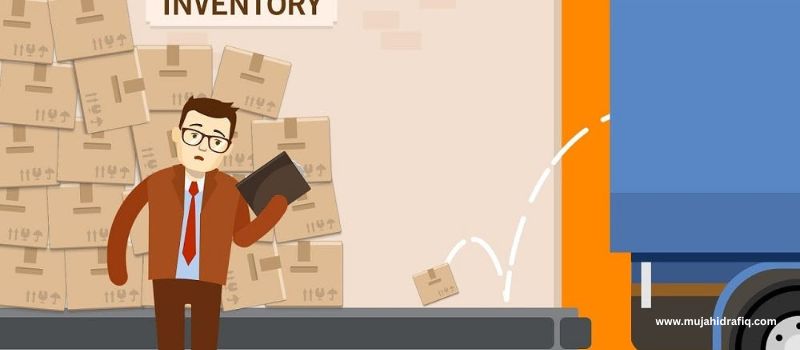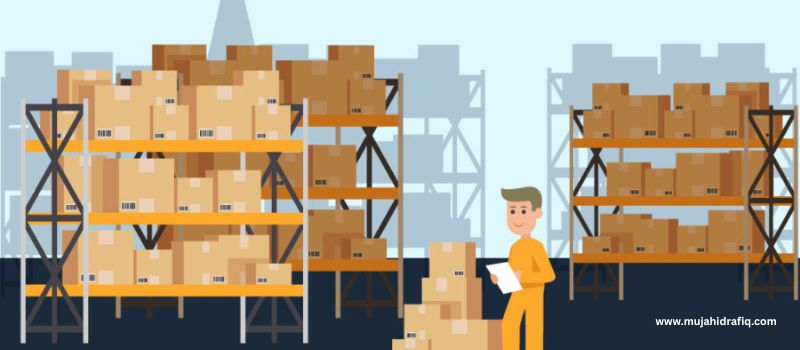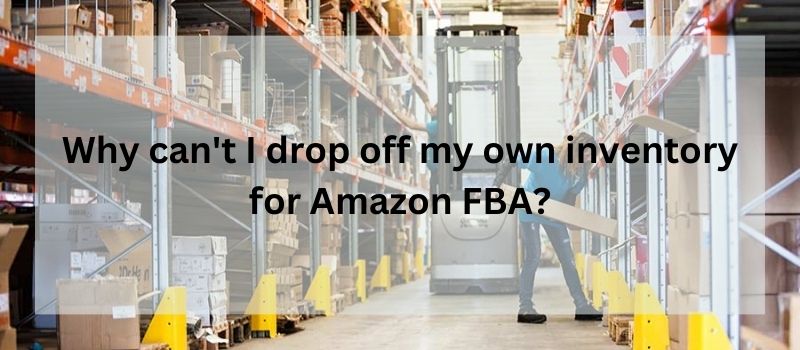If you’re an Amazon seller looking to use Fulfillment by Amazon (FBA) services, you may be wondering why Amazon doesn’t allow you to simply drop off products at their warehouses yourself. It’s a fair question, especially if you have a small number of items or are located near an Amazon facility.
However, Amazon has some valid reasons for requiring FBA inventory to be shipped through designated carriers instead.
Contents
- 0.1 Why can’t I drop off my own inventory for Amazon FBA?
- 0.2 What is FBA (Fulfillment by Amazon)?
- 0.3 Why Amazon Doesn’t Allow Self Drop-Offs
- 0.4 What are the Alternatives for Sending Inventory to Amazon?
- 0.5 Tips for Getting Your FBA Inventory to Amazon
- 0.6 What Steps to Take if You Have Problems Shipping FBA Inventory
- 0.7 FAQs
- 0.7.1 Can I deliver FBA shipments to Amazon on weekends or nights?
- 0.7.2 What if I miss my scheduled FBA shipment appointment?
- 0.7.3 How much does it cost to use FBA shipping partners?
- 0.7.4 Can I track my FBA inventory in transit to Amazon?
- 0.7.5 What happens if I ship prohibited products to Amazon FBA?
- 0.7.6 Do I need to apply or register to use Fulfillment by Amazon?
- 1 Conclusion
Why can’t I drop off my own inventory for Amazon FBA?
Amazon does not allow sellers to personally drop off FBA inventory at their warehouses. This is due to security concerns, challenges tracking and reconciling inventory, and extra costs associated with facilitating random seller deliveries. Instead, Amazon requires use of approved shipping partners like UPS, FedEx and trucking companies that integrate with their receiving systems.
While less convenient, this inventory prep and delivery protocol allows Amazon to efficiently manage their sophisticated fulfillment operation. If you have issues getting FBA products to Amazon, consider hiring a prep and shipping company to expertly handle logistics.
What is FBA (Fulfillment by Amazon)?
First, let’s make sure we’re on the same page regarding what exactly FBA is. FBA is Amazon’s fulfillment service where they pick, pack, ship and provide customer service for your products sold on Amazon.
Basically, when a customer purchases something you’re selling on Amazon, Amazon handles getting it to them instead of you having to do it yourself.
Definition of FBA
So in essence, FBA means Fulfillment by Amazon. It’s their branded fulfillment service offered to third-party sellers on the Amazon marketplace. You send your products to Amazon’s warehouses in bulk and they take care of order fulfillment as products are sold.
How FBA Works
The FBA process works like this: you prepare and label your products to Amazon’s specifications, then ship them to Amazon using one of their partnered shipping methods. Amazon stows the inventory, pulls items as they are ordered, packs and ships them, and provides customer service for any issues.
You pay Amazon fees for storage space and order fulfillment, but save time while reaching Amazon’s large customer base.
Benefits of Using FBA
The main reasons sellers opt to use FBA include:
- Access to Prime members for faster shipping and higher sales
- Amazon handles storage, packing, and shipping for you
- Better customer service due to Amazon’s systems and processes
- Can focus time on growing your business instead of order logistics
So in short, FBA makes selling on Amazon easier by handing fulfillment operations off to their experienced team. But it comes at a cost and means relinquishing some control over your inventory.

Why Amazon Doesn’t Allow Self Drop-Offs
This brings us back to our original question – why can’t sellers simply drop products off themselves if they are already near an Amazon facility? It’s not an unreasonable request, especially for smaller sellers with limited inventory. However, Amazon has a few valid reasons why this isn’t allowed:
Security and Accountability
First and foremost, allowing random sellers to access their facilities would pose security risks and make it harder to keep track of inventory. Amazon warehouses are finely tuned operations, so they need strict control over what comes in and out. While inconvenient for sellers, restricting access helps prevent issues down the line.
You know, as an amazon fba expert I once tried to drop off some inventory myself at a nearby Amazon warehouse. as an amazon fba expert I showed up with a few boxes and tried to explain my situation to the security guards.
Though understanding, they made it clear unscheduled drop-offs were strictly against protocol. So I get why Amazon is so strict about these policies – it would be chaos otherwise!
Inventory Tracking Challenges
Which leads to the next point – inventory tracking. Amazon uses advanced tracking systems to account for each item in their fulfillment centers. Random seller drop-offs would essentially be “off the books” inventory not tied to inbound shipment orders in their systems.
So, if you showed up with a pallet of your products, Amazon wouldn’t have visibility or be able to reconcile those items correctly within their existing inventory data. It may seem like extra work, but requiring products to come via approved shipping channels lets Amazon keep accurate counts and better monitor inventory.
Additional Costs and Logistics
Allowing seller drop-offs could also create additional costs and logistical issues for Amazon. They would need to devote more staff and resources to facilitate and process random inventory deliveries.
It might require extra equipment, loading docks, personnel, etc. that don’t fit cleanly within their optimized fulfillment workflows. Not to mention, it could allow some sellers to unfairly bypass shipping costs if they happen to be located closer to Amazon facilities than others. So it simplifies things for Amazon to rely on consistent shipping methods instead.

What are the Alternatives for Sending Inventory to Amazon?
Just because you can’t drop FBA inventory off yourself doesn’t mean there aren’t solid ways to get your products to Amazon. You’ll just need to utilize one of their integrated shipping partners:
Using Amazon Partnered Carriers
Amazon has negotiated special rates with major carriers like UPS, FedEx, and USPS for FBA inventory. When sending FBA shipments, you can take advantage of these discounts as long as you properly prepare, label, and send inventory using Amazon’s shipping guidance.
For example, I’ve saved roughly 20% on UPS shipping by using Amazon’s UPS integration compared to just setting up a UPS account myself. Just make sure to use the exact service they specify – no deviations allowed to still get the deal!
Shipping Inventory to Amazon Warehouses
Alternatively, Amazon has deals with trucking companies that specialize in transporting pallets of inventory directly to their warehouse loading docks. This option works best for large inventory shipments of hundreds or thousands of units.
It does involve some coordination with the shipping company to schedule delivery appointments and prepare palletized loads. But it can be pretty cost-effective if you have enough volume. Just search for “Amazon trucking partners” to find recommended companies.
Hiring Prep and Shipment Companies
If prepping and shipping inventory yourself seems too complex, you might consider hiring an prep company to handle everything for you. These services will consult with you to understand your products, then properly prep, label and ship them via the best method to Amazon’s warehouses per their requirements.
Yes, it adds an additional cost to pay a third-party company compared to doing it in-house. But the time and headache savings are often worth it, especially at the startup stages. Just be sure to do your due diligence by vetting companies to ensure they are reputable experts in Amazon shipping.
Tips for Getting Your FBA Inventory to Amazon
Okay, so now you know why Amazon insists sellers use approved inbound methods and what the alternatives are. Here are some quick tips to actually get your FBA inventory delivered to Amazon:
Properly Prepare and Label Products
Amazon gives very detailed rules around item prep and labeling for FBA products – follow them precisely! This means putting FNSKU labels on each unit, bagging or boxing items as specified, taping boxes correctly etc. Sloppy prep can mean extra fees or rejection.
Use Amazon Approved Shipping Methods
As an amazon fba expert I can’t stress this enough – only use carriers and services Amazon specifies for that particular facility! Whether UPS, USPS, FedEx or a trucking/logistics company, verify the prep guidance matches what Amazon outlined.
Consider Hiring Help for Large Shipments
If sending large quantities or pallets, think about having a professional prep company handle the packaging and shipping logistics. Adding costs saves effort and helps avoid problems with large loads.

What Steps to Take if You Have Problems Shipping FBA Inventory
Despite best efforts, you may occasionally run into hiccups getting inventory delivered to Amazon facilities. Issues like shipping delays, incorrectly prepped items or load rejections can arise. Here are some tips if you encounter problems:
Contact Seller Support for Guidance
Don’t hesitate to contact Amazon Seller Support if you run into any inventory issues. They can look into the situation, explain what went wrong, and advise on next steps. Their job is to help sellers, so take advantage if you have questions or problems!
Review Program Policies and Restrictions
It never hurts to review Amazon FBA inventory prep and delivery requirements whenever you hit snags. Often times sellers overlook updated guidance or miss key details that cause problems. Brush up on the exact policies for your product category and look for gaps.
Adjust Shipment Plans if Needed
Finally, be open to tweaking your inbound shipping approach if you struggle with initial attempts. If certain carriers aren’t working, explore alternatives Amazon recommends for FBA deliveries. Or consider working with a prep and delivery service if handling the logistics in-house isn’t a priority.
FAQs
Can I deliver FBA shipments to Amazon on weekends or nights?
No, Amazon only allows scheduled appointments for inbound deliveries during normal business hours. Weekend or evening drop-offs are not permitted.
What if I miss my scheduled FBA shipment appointment?
You’ll have to contact the carrier to reschedule or possibly pay extra fees depending on Amazon’s policies if you miss the delivery window.
How much does it cost to use FBA shipping partners?
Shipping rates vary by carrier, weight, facility location and other factors. But FBA partners offer 10-30% discounts versus standard pricing.
Can I track my FBA inventory in transit to Amazon?
Yes, Amazon provides tracking info so sellers can monitor shipments every step of the way using each carrier’s tracking tools.
What happens if I ship prohibited products to Amazon FBA?
Shipping prohibited items can result in bans, disposal fees, and lost inventory, so carefully vet all products before sending to Amazon.
Do I need to apply or register to use Fulfillment by Amazon?
No application is needed, but you’ll need an Amazon Seller Central account. Simply search for FBA features to access tools for shipping.
Conclusion
So in the end, while not allowing self drop-offs creates some seller hassle, Amazon ultimately has legitimate reasons for restricting FBA inventory delivery methods. Between security, inventory tracking and operational concerns, they simply require products enter facilities via approved channels they can appropriately monitor and control.
As the saying goes, you have to crack some eggs to make an omelet! Despite the inconvenience as sellers, we ultimately benefit from Amazon’s world-class fulfillment operation. Even if it means cautiously packaging and shipping our wares to their precise specifications at times.
So be sure to carefully prep and clearly label FBA products, leverage recommended carriers for cost savings, and don’t hesitate to lean on seller support or experts if inventory issues arise.
With some care taken upfront around delivery logistics, you’ll be rewarded with excellent service and strong sales through Fulfilled by Amazon once inventory reaches their fulfillment centers. The key is getting it there in one piece – something the approved shipping partners can assist with.
Read More:



